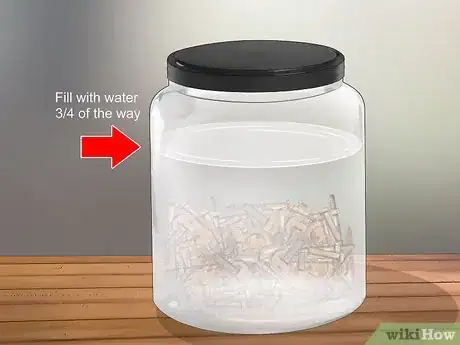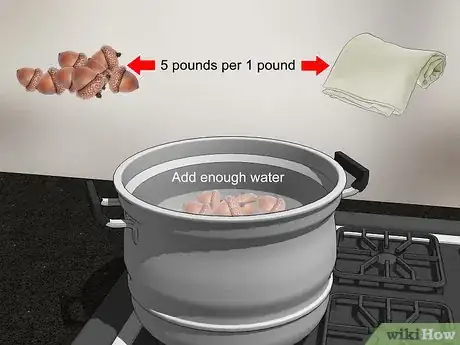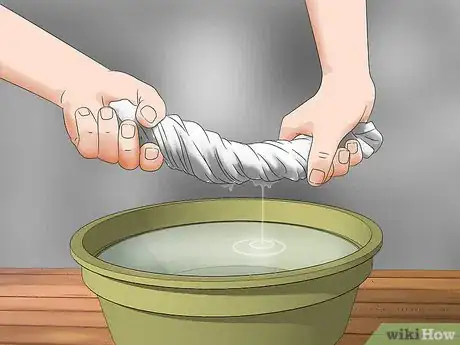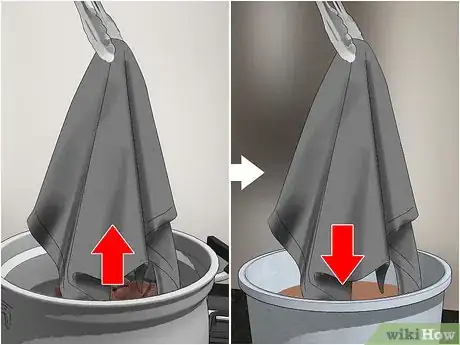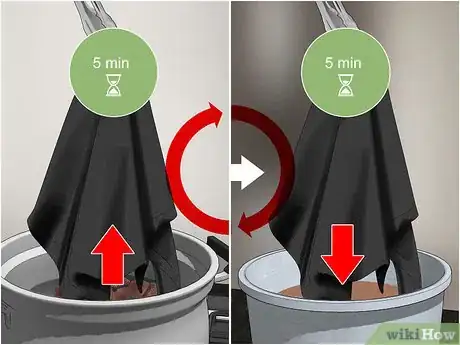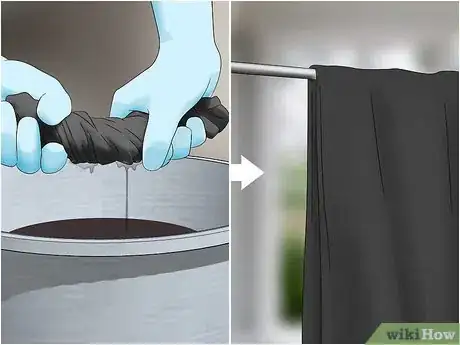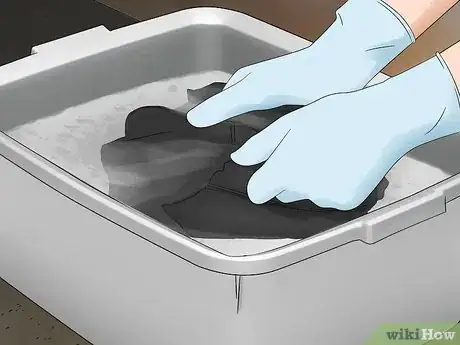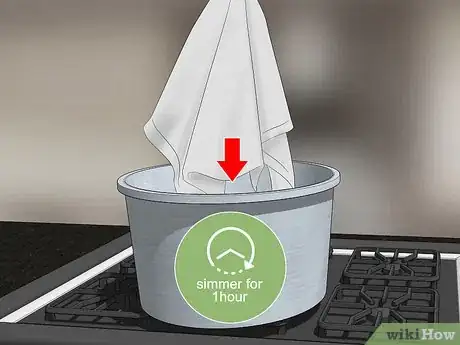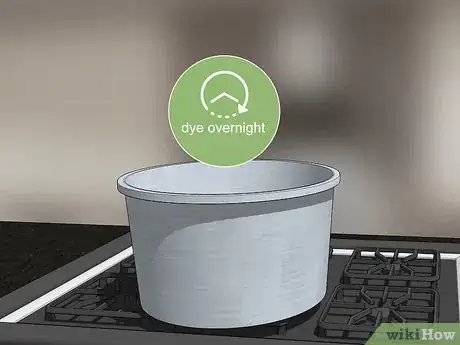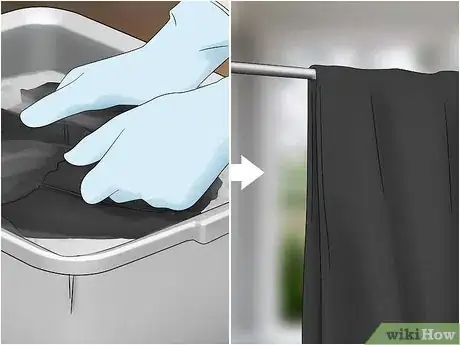This article was co-authored by wikiHow Staff. Our trained team of editors and researchers validate articles for accuracy and comprehensiveness. wikiHow's Content Management Team carefully monitors the work from our editorial staff to ensure that each article is backed by trusted research and meets our high quality standards.
This article has been viewed 189,141 times.
Learn more...
Natural dyes are a pretty way to add some color to your clothes. And while black is one of the hardest shades to achieve without artificial chemicals or dyes, it's totally possible with a little patience and experimenting. Whether you use acorns from the backyard or iris roots, the secret is soaking your fabric in a homemade fixative first. So dig up those old T-shirts and start dyeing!
Steps
Making Dye out of Iron and Acorns
-
1Place 2 handfuls of rusty objects and 1 cup (240 ml) of vinegar in a jar. Use items with iron that rust easily like nails, screws, steel wool, or bolts. The more rust on the objects, the more effective your dye will be.[1]
- If you don’t have a glass jar, use any other large glass container with a lid.
- You can buy iron powder from an online retailer if you don’t have rusty objects. Simply mix the powder into the vinegar.
Making Your Own Rusted Nails
Place your nails in a container or bowl and soak them in white vinegar for 5 minutes. Drain the vinegar, then pour hydrogen peroxide over the nails. For extra rust, sprinkle some sea salt into the mixture, too. Remove the nails from the liquid and let them air dry. You'll notice them start rusting immediately!
-
2Fill the jar 3/4 of the way with water, then seal it. Make sure the rusty objects are completely covered so they’ll soak properly. Screw the lid on tightly to prevent the liquid from evaporating.[2]
- You can use any temperature water, from cold to lukewarm to hot.
Advertisement -
3Set the jar in the sun for 1 to 2 weeks until the liquid is orange. An area that gets direct sunlight and is very warm will work best. The water and vinegar mixture should turn a copper shade due to the reaction between the iron from the rust and the vinegar.[3]
- Good places for your jar include a deck, driveway, or windowsill.
- The orange liquid created is known as an iron mordant.
-
4Combine acorns with water in a large pot. Use 5 pounds (2.3 kg) of acorns per 1 pound (0.45 kg) of fabric. For example, if you have 1⁄2 pound (0.23 kg) of fabric, you’ll need 2 1⁄2 pounds (1.1 kg) of acorns. Add enough water to cover both the acorns and the fabric.[4] .
- Find acorns in any wooded area with oak trees or order them online.
- Weigh your acorns using a food scale or a regular scale.
- Use a stainless steel or glass pot. Copper or aluminum pots can react with the dye.
-
5Let the acorns simmer in the water for 1 to 2 hours. Place the pot over low to medium heat, stirring the acorns occasionally. This cooking process helps extract the natural color from the nuts.[5]
- A simmer often occurs between 195 and 211 °F (91 and 99 °C) and has tinier, slower bubbles than a rolling boil.[6]
-
6Wet your fabric and squeeze out any excess water. Dip your fabric in water or run it under the sink. Wring it out thoroughly so it’s damp, but not dripping.[7]
- Pre-wetting your fabric prevents splotchy coloring and allows the dye to spread evenly throughout the material.
How to Choose Fabric for Dyeing
Material: Natural fabrics like wool, silk, and muslin absorb dye easily. Cotton and synthetic fabrics don't dye as well.
Color: Light-colored fabrics are best for dyeing. Look for white, cream, or very pale pastels.
Extras: Keep in mind that if embroidery or thread isn't polyester, you'll have to cover it in a batik wax to keep its original color.
-
7
-
8Combine the iron solution and water in a separate pot. This is what you'll dip the fabric in after you dye it. Use enough water to completely cover the fabric.[10]
- You can do this while the fabric is simmering in the dye.
-
9Remove the fabric from the dye and set it in the iron pot for 10 minutes. Gently swish the fabric around in the pot with a large spoon to make sure it’s evenly coated. The reaction between the iron and the dye is what darkens and sets the color.[11]
- Use a stainless steel spoon to stir the fabric. A wooden spoon will be permanently stained by the dye.
-
10Alternate soaking the fabric in the dye and the iron to darken it. If you aren’t satisfied with the color after the original 10 minutes is up, place the fabric back in the acorn dye for 5 minutes. Then put it into the iron mixture again for another 5 minutes.[12]
- Continue this alternating process until the color is dark enough.
-
11Wring out the dye and let the fabric dry for 1 hour before washing it. Hang the fabric in a sunny spot outside or lay it over a drying rack in the laundry room. This gives the dye a chance to set before you wash it.[13]
- Place an old sheet or a drop cloth underneath the fabric as it dries to collect any drips of dye. They will stain any carpet or nearby fabric.
-
12Wash the fabric with cool water and soap to remove any excess dye. Check the care instructions for your fabric. If it can be machine-washed, put it in the washing machine with a mild laundry soap and turn the dial to the cold water setting. Otherwise, wash the fabric by hand.[14]
- If you’re washing it by hand, you’ll know all the dye has been removed when the water runs clear and is no longer colored.
- Wash the fabric separately if you're using a washing machine so you don't stain other clothes.
Using Iris Roots to Dye Fabric
-
1Place 1 part vinegar and 4 parts water along with your fabric in a pot. This mixture will act as a color fixative to help the dye stick to the fabric. Use enough water to completely cover the fabric.[15]
- For example, for every 1 cup (240 ml) of vinegar, you’ll need 4 cups (950 ml) of water.
- White vinegar works best for dyeing.
- Light-colored, natural fabric like pale silk or white muslin absorb dye the best. Avoid dyeing dark or synthetic fabric.
-
2Simmer the mixture for 1 hour, stirring occasionally. Turn the stove on low heat, bringing the water and vinegar solution to a light simmer. Use a spoon to move the fabric around in the pot so the liquid seeps into every spot.[16]
- Vinegar has a slightly higher boiling point than water so it will take longer to heat up.
-
3Remove the fabric from the pot and rinse it in cold water. After letting it simmer for 1 hour, you're now ready to dye the fabric. Run it under cool water in the sink for 1 to 2 minutes, just to remove some of the vinegar.[17]
- You can also dip the fabric into a basin filled with cold water to rinse it.
- Don't worry about the strong vinegar odor. That will be removed when you wash the fabric after dyeing it.
-
4Combine 1 part iris roots with 2 parts water in a separate pot. Again, you’ll want enough water in the pot to cover the fabric. If you use 2 cups (470 ml) of iris roots, for example, pour in 4 cups (950 ml) of water.[18]
- Dye can be poisonous so pick a pot that you won’t use for cooking again.
- Buy iris roots from a plant nursery or an online retailer.
- You can soak the roots whole or chop them into smaller pieces to fit in your pot.
-
5Place the wet fabric in the dye and let it simmer for 1 hour. Over low heat, bring the dye bath to just below boiling. Stir the fabric every so often, making sure it’s totally submerged and gets evenly coated in dye.[19]
- The bottom of the pot is the hottest so the dye is more intense there. As you stir, flip the fabric over so one area doesn’t get darker than the others.[20]
- If you want to use your hands to mix the fabric in the dye, wear rubber gloves to protect them.
-
6Let the fabric soak in the dye overnight if you want a darker color. The longer the fabric sits in the dye bath, the darker black it will be. This will likely be necessary if you’re using synthetic fabrics which don’t absorb dye as readily.[21]
- Keep in mind that the color will get lighter once the fabric dries.[22]
- Cover your pot with a lid or place it out of reach of children and pets while it sits overnight since dye can be poisonous.
-
7Wash the fabric with cold water and detergent, then let it dry. Look at the tag on the clothing to see if your item can be machine-washed or tumble-dried. If there’s no tag, err on the side of caution and hand wash your fabric using cool water and a mild soap. Then toss it in the dryer or hang it up outside.[23]
Washing tip: Don’t wash newly dyed fabric with other clothes as the dye can spread and stain the other pieces.
Community Q&A
-
QuestionWhat can I use to dye clothes black?
 Drew Hawkins1Community AnswerTry making a black dye out of iron and acorns that you can use on your clothes! Start by placing 2 handfuls of rusty objects like nails, screws, or bolts into 1 cup (240 ml) of vinegar in a jar. Then, fill the jar 3/4 of the way with water and seal it. Set the jar in the sun for 1 to 2 weeks until the liquid is orange. Add 5 pounds (2.3 kg) of acorns per 1 pound (0.45 kg) of fabric, place the acorns in a large pot, cover them with water, and let it simmer for 1-2 hours. Add your fabric to the acorn pot for 20-45 minutes, then remove it and soak it in a pot with the vinegar and iron mixture for 10 minutes. Alternate soaking the fabric in the dye and the iron until it's as black as you want it to be.
Drew Hawkins1Community AnswerTry making a black dye out of iron and acorns that you can use on your clothes! Start by placing 2 handfuls of rusty objects like nails, screws, or bolts into 1 cup (240 ml) of vinegar in a jar. Then, fill the jar 3/4 of the way with water and seal it. Set the jar in the sun for 1 to 2 weeks until the liquid is orange. Add 5 pounds (2.3 kg) of acorns per 1 pound (0.45 kg) of fabric, place the acorns in a large pot, cover them with water, and let it simmer for 1-2 hours. Add your fabric to the acorn pot for 20-45 minutes, then remove it and soak it in a pot with the vinegar and iron mixture for 10 minutes. Alternate soaking the fabric in the dye and the iron until it's as black as you want it to be. -
QuestionWhat is a natural black dye?
 Drew Hawkins1Community AnswerIris roots can be used to make a natural black dye. Place the fabric you want to die in a pot with 1 part vinegar and 4 parts water. Simmer the mixture for 1 hour, stirring occasionally. Then, run it under cool water in the sink for 1 to 2 minutes, just to remove some of the vinegar. Combine 1 part iris roots with 2 parts water in a separate pot, place the wet fabric in the dye and let it simmer for 1 hour. If you want the fabric to be really dark, let it soak in the dye overnight. Then, wash your fabric using cool water and a mild soap and toss it in the dryer or hang it up outside to dry.
Drew Hawkins1Community AnswerIris roots can be used to make a natural black dye. Place the fabric you want to die in a pot with 1 part vinegar and 4 parts water. Simmer the mixture for 1 hour, stirring occasionally. Then, run it under cool water in the sink for 1 to 2 minutes, just to remove some of the vinegar. Combine 1 part iris roots with 2 parts water in a separate pot, place the wet fabric in the dye and let it simmer for 1 hour. If you want the fabric to be really dark, let it soak in the dye overnight. Then, wash your fabric using cool water and a mild soap and toss it in the dryer or hang it up outside to dry. -
QuestionCan you dye any fabric black?
 Drew Hawkins1Community AnswerMost fabrics made out of natural fibers can be dyed black. That includes cotton, silk, and wool. But if the fabric is made out of synthetic materials like polyester, spandex, and acrylic, it may not be possible with a standard dye. However, there are black fabric dyes that are made specifically for synthetic fibers, so look for one of those if you're trying to dye clothes or fabrics with synthetic fibers.
Drew Hawkins1Community AnswerMost fabrics made out of natural fibers can be dyed black. That includes cotton, silk, and wool. But if the fabric is made out of synthetic materials like polyester, spandex, and acrylic, it may not be possible with a standard dye. However, there are black fabric dyes that are made specifically for synthetic fibers, so look for one of those if you're trying to dye clothes or fabrics with synthetic fibers.
Things You’ll Need
Iron and Acorn Dye
- Fabric
- 2 handfuls of rusty items
- 1 cup (240 ml) of white vinegar
- Water
- Acorns
- Large jar with a lid
- 2 large pots
- Spoon
- Clothesline or drying rack
- Washing machine (optional)
Iris Root Dye
- Fabric
- Iris roots
- Vinegar
- Water
- 2 large pots
- Spoon
- Clothesline or drying rack
- Washing machine (optional)
Warnings
- Never cook with a pot that's been used for dyeing, as it can be poisonous.⧼thumbs_response⧽
- If you accidentally ingest dye, call your doctor or go to the emergency room immediately.⧼thumbs_response⧽
- Wear rubber gloves when handling dye if you have sensitive skin.⧼thumbs_response⧽
- Dye can permanently stain other fabrics so wear old clothes or put down drop cloths when you're dyeing.⧼thumbs_response⧽
References
- ↑ http://tabletopparty.squarespace.com/blog/2014/11/3/diy-natural-acorn-dye
- ↑ http://tabletopparty.squarespace.com/blog/2014/11/3/diy-natural-acorn-dye
- ↑ http://tabletopparty.squarespace.com/blog/2014/11/3/diy-natural-acorn-dye
- ↑ http://tabletopparty.squarespace.com/blog/2014/11/3/diy-natural-acorn-dye
- ↑ http://tabletopparty.squarespace.com/blog/2014/11/3/diy-natural-acorn-dye
- ↑ https://www.tasteofhome.com/article/boil-vs-simmer/
- ↑ http://tabletopparty.squarespace.com/blog/2014/11/3/diy-natural-acorn-dye
- ↑ http://tabletopparty.squarespace.com/blog/2014/11/3/diy-natural-acorn-dye
- ↑ https://www.apartmenttherapy.com/how-to-dye-with-acorns-138657
- ↑ http://tabletopparty.squarespace.com/blog/2014/11/3/diy-natural-acorn-dye
- ↑ http://tabletopparty.squarespace.com/blog/2014/11/3/diy-natural-acorn-dye
- ↑ http://tabletopparty.squarespace.com/blog/2014/11/3/diy-natural-acorn-dye
- ↑ http://tabletopparty.squarespace.com/blog/2014/11/3/diy-natural-acorn-dye
- ↑ http://tabletopparty.squarespace.com/blog/2014/11/3/diy-natural-acorn-dye
- ↑ https://pioneerthinking.com/natural-dyes
- ↑ https://pioneerthinking.com/natural-dyes
- ↑ https://pioneerthinking.com/natural-dyes
- ↑ https://pioneerthinking.com/natural-dyes
- ↑ https://pioneerthinking.com/natural-dyes
- ↑ https://www.ndsu.edu/pubweb/chiwonlee/plsc211/student%20papers/articles04/petra%20Guenthner-Johnson/dyes.html
- ↑ https://pioneerthinking.com/natural-dyes
- ↑ https://www.moneycrashers.com/how-to-dye-fabric-clothes-make-natural-dyes/
- ↑ https://pioneerthinking.com/natural-dyes

